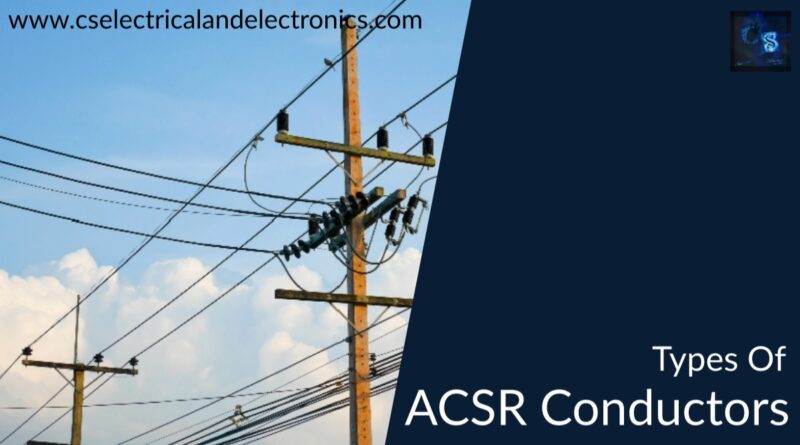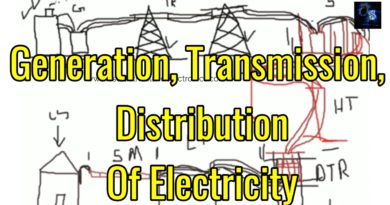Types of ACSR Conductors Used In LT, HT And Transmission Line
Hello guys, welcome back to our blog. Here in this article, we will discuss the types of ACSR conductors used in the LT line, HT line, and transmission line, what is the LT line, what is the HT line, and what is transmission line.
If you have any electrical, electronics, and computer science doubts, then ask questions. You can also catch me on Instagram – CS Electrical & Electronics.
Also, read:
- What Is Thermal Management In Electric Vehicle, Purpose, Causes
- Top 10 BMS Manufacturing Companies In The World, Battery Management System
- Fault Management In BMS, Battery Management System, Purpose, Survey
Types of ACSR Conductors
First, I will discuss what is A.C.S.R Conductor? A.C.S.R means Aluminium Conductor Steel Reinforced.
In this conductor, aluminum and steel material is used. The A.C.S.R conductor is made up of a number of strands as shown in the below image, strands mean single stand conductor which is made up of either aluminum or steel.
The purpose of using strands in conductors is to make conductors flexible. The outer strands in the conductor are made of aluminum and inner strands are made of steel.
1. LT lines
The Conductors used to transmit Electricity from Double Pole Structure ( Distribution Transformer ) to Consumers are known as LT lines. LT lines are drawn in every street and area. The 11 KV voltage is fed to DP Structure by HT lines, in DP Structure distribution transformer is used which will step down the voltage from 11 KV to 440 volts (for 3 Phase) to 230 volts (for single Phase), this 440 V is carried by LT lines. In the LT line four wires are used, three conductors for three-phase ( RYB ), and one conductor for Neutral.
At last, the Electricity is supplied to the meter board by using Overhead Service Mains and Underground Service Mains. LT lines mean a low tension line that carries a low voltage of 440 volts between phases and 230 volts between phase and neutral. The purpose of the low tension line is to transmit energy from the distribution transformer to consumers.
Now I will tell you which conductor is used in low tension lines, in low tension lines two different A.C.S.R conductors are used one for phase and another for neutral.
The conductor which is used for phase is Weasel 6/1/2.59 mm and the conductor used for neutral is squirrel 6/1/2.11. what is 6/1/2.59 mm in phase and 6/1/2.11 mm in neutral?
It is the size of the conductor, in phase conductor, there are 6 aluminum strands, 1 steel strands and the diameter of each strand is 2.59 mm whereas in neutral conductor 6 aluminum strands are their, 1 steel strand and diameter of each strand is 2.11 mm. Therefore, for phase weasel conductor of size 6/1/2.59 mm is used and for neutral squirrel conductor of size 6/1/2.11 mm is used.
2. HT lines
The Conductors used to transmit Electricity from Sub-stations to Distribution Transformer ( Double Pole Structure ) are known as HT Lines. HT Lines are erected only at main roads of Cities or villages. In the Substation voltage of Transmission, the line is step-down to 11KV, this 11KV voltage is transmitted to Distribution Transformer ( Double Pole Structure ) by HT lines.
At Double Pole Structure, the distribution transformer is used which will step-down the 11 KV voltage to 440 volts. In HT lines we can see only three lines nothing but three phases three conductors but the neutral wire is absent because in sub-station neutral wire coming from Power Transformer is grounded.
The conductor used in a high tension line is Rabbit 6/1/3.35 mm here also a number of aluminum strands are 6, a number of steel strands are 1 and the diameter of each strand is 3.35 mm.
3. Transmission line
Transmission lines are nothing but Conductor used to transmit Electricity from generating station to Sub-stations. In Transmission lines, the conductors are supported by steel Structure. Transmission towers are erected outside the cities because they carry high voltage which will be harmful to both Birds and Human beings. In transmission lines, ground clearance should be more.
Classification of Transmission tower
- (01). Single Circuit Transmission tower
- (02). Double Circuit Transmission tower
- (03). Four Circuit Transmission tower
Concept of Single Circuit and Double Circuit Transmission lines
In a single circuit transmission line, three conductors corresponding to three distinct phases i.e., R, Y, and B phases are run on the transmission towers. Whereas in a double circuit transmission line total of six conductors are provided to make two different transmission circuits.
In a double circuit transmission line, the number of circuits is two each consisting of three conductors corresponding to three phases. In a double circuit Transmission line, bundle conductors are mostly wired.
If the number of conductors per bundle is 2 then it will be 220 KV line while if the number of conductors per bundle is four then it will be 400 KV line. Double circuits are used where greater reliability is needed. This system of transmission enables the transfer of more power over a particular distance.
This transmission is thus cheaper and requires less land and is considered ideal from an ecological and aesthetic point of view. Further, due to the double circuit transmission line the reliability of power supply increases. Not only reliability rather maintenance opportunity also increases.
Transmission line Voltage – 66 KV, 110 KV, 220 KV, 400 KV, 745 KV.
Transmission line means which carries high voltage such as 66 KV, 110 KV, and 220 KV. The purpose of the transmission line is to transmit energy from the generation station to substations. The conductor used in 66 KV lines is ACSR Coyote 30/2.54 Aluminium strands and 7/1.9 mm Steel strands. i.e., 30 aluminum strands with a diameter of 2.54 mm and 7 steel strands with a diameter of 1.9 mm are used in A.C.S.R Conductor.
The conductor used in 110 KV lines is Lynx 30/7/2.79 mm i.e., 30 numbers aluminum strands, 7 numbers steel strands, and the diameter of each strand is 2.79 mm. The conductor used in the 220 KV line is Drake 30/7/4.27 mm i.e., 30 numbers aluminum strands, 7 numbers steel strands, and the diameter of each strand is 4.27 mm.
Tags: Types of ACSR conductors, rabbit ACSR conductor, squirrel ACSR conductor, Coyote ACSR conductor, Drake ACSR conductor, Lynx ACSR conductor, what is LT line, what is HT line, what is a transmission line, Types of ACSR Conductors Used In LT Line, HT Line And Transmission Line.
Also, read:
- 10 Tips To Maintain Battery For Long Life, Battery Maintainance
- 10 Tips To Save Electricity Bills, Save Money By Saving Electricity
- 100 (AI) Artificial Intelligence Applications In The Automotive Industry
- 100 + Electrical Engineering Projects For Students, Engineers
- 1000+ Control System Quiz, Top MCQ On Control System
- 1000+ Electrical Machines Quiz, Top MCQs On Electrical Machines
- 1000+ MATLAB Simulink Projects For MTech, Engineering Students
- 50 Tips To Save Electricity At Home, Shop, Industry, Office
Author Profile
- Chetu
- Interest's ~ Engineering | Entrepreneurship | Politics | History | Travelling | Content Writing | Technology | Cooking
Latest entries
 All PostsApril 19, 2024What Is Vector CANoe Tool, Why It Is Used In The Automotive Industry
All PostsApril 19, 2024What Is Vector CANoe Tool, Why It Is Used In The Automotive Industry All PostsApril 13, 2024What Is TCM, Transmission Control Module, Working, Purpose,
All PostsApril 13, 2024What Is TCM, Transmission Control Module, Working, Purpose, All PostsApril 12, 2024Top 100 HiL hardware in loop Interview Questions With Answers For Engineers
All PostsApril 12, 2024Top 100 HiL hardware in loop Interview Questions With Answers For Engineers All PostsMarch 22, 2024Driver Monitoring Systems In Vehicles, Working, Driver Sleepy Alert
All PostsMarch 22, 2024Driver Monitoring Systems In Vehicles, Working, Driver Sleepy Alert








I am regular reader, how are you everybody? This piece of writing posted at
this website is truly pleasant.
thanks for sharing a knowledge “ACSR Conductor “